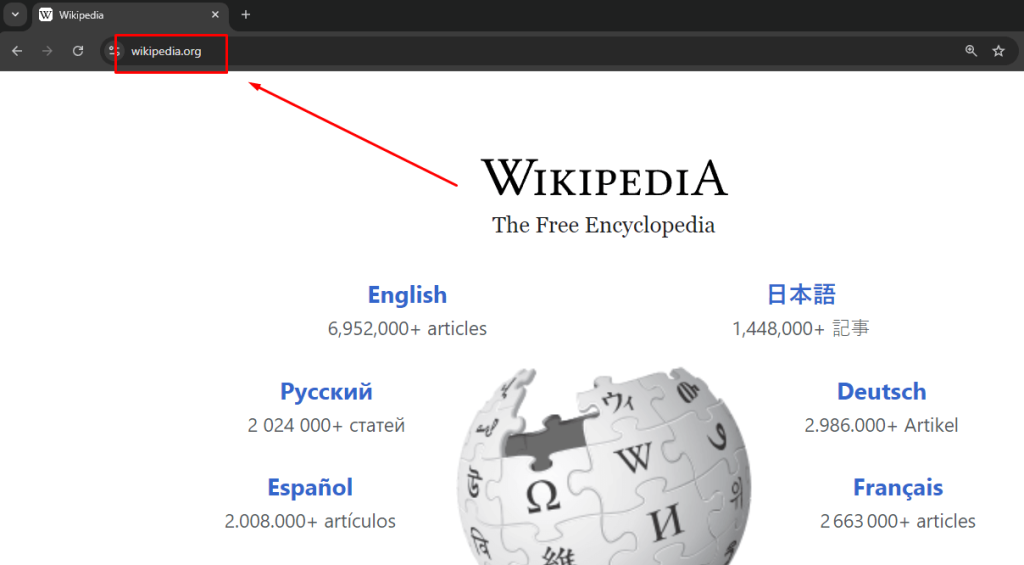We first explain what ccTLDs are by shedding light on domain extensions and country codes.
ccTLDs are a specific category within the broader context of Top-Level Domains (TLDs).
Domain extension and country code top-level domain
You may know that a domain extension is the part of the URL that follows a domain name, such as:
- .com
- .org
- .edu
The domain name extensions above are to show that the website is commercial, an organization, or an educational institution. Below, you can see an example of a .org website:

A ccTLD top-level domain is a domain name extension that represents a particular country or territory. Think of it as a digital-specific country code for websites, allowing you to know if a country is a sovereign state or a dependent territory.
Country domains have a web address that lets you know which geographical region the website owner is in. This ccTLD domain name system is very handy.
Just like a postal code helps identify a physical address, a ccTLD helps identify the geographic origin of a website. The DNS plays a crucial role in organizing and facilitating Internet navigation and domain registration.
Here are some ccTLDs as an example:
- .ca for Canada
- .au for Australia
- .fr for France
- .de for Germany
- .jp for Japan
These ccTLD endings help users identify websites associated with a particular geographical area. A business in Canada may use .ca to signal its location to Canadian customers. In contrast, a news site focused on the UK would likely use .uk. These gTLDs are not country-specific like a ccTLD. ccTLDs are just one type among various categories of TLDs, with other types serving different purposes within the domain naming system.
Where do ccTLDs originate from?
ccTLDs are based on the ISO 3166-1 alpha-2 country codes. Each ccTLD’s two-letter code directly corresponds to a country or territory. This system makes it easy to associate a website with its origin. Various organizations, such as Network Information Centres (NICs) and ccTLD registries, are responsible for managing the registration and administration of ccTLDs.
For instance, hostpapa.co.uk clearly indicates a connection to the United Kingdom, while a hostpapa.ca ccTLD points to Canada.
While country code TLDs denote a country, it’s important to differentiate them from generic top-level domains (gTLDs), for example, .com, .org, or .net. These gTLDs are not country-specific like a ccTLD.
History and development of ccTLDs
The concept of country code Top-Level Domains (ccTLDs) dates back to the early days of the Internet. In 1985, the Internet Assigned Numbers Authority (IANA) began approving requests from countries to use specific ccTLD identifiers.
These identifiers were based on the ISO 3166-1 country codes, with a few exceptions like .uk for the United Kingdom and .eu for the European Union. The first ccTLDs, such as .us for the United States, were introduced in the late 1980s.
The development of ccTLDs was driven by the need for countries to have their unique identifiers on the Internet. This allowed countries to manage their domain name systems and provided a way for organizations and individuals to register domain names that were specific to their country.
Over time, the number of ccTLDs has grown to over 300, with new ones being added regularly. This expansion has helped promote the development of the Internet in countries around the world, giving each nation a digital identity and a way to manage its online presence.
How ccTLDs differ from gTLDs
ccTLDs and generic Top-Level Domains (gTLDs) are both types of top-level domains, but they differ in several ways. While gTLDs, such as .com, .org, and .net, are not tied to any specific country and can be registered by anyone, ccTLDs are specifically designated for a particular country or geographic territory. For example, .in is the ccTLD for India, and .uk is for the United Kingdom.
Another difference is the level of regulation. ccTLDs are typically regulated by the country or territory in which they are registered. This means that each country can set its own rules and regulations for the use of its ccTLD.
In contrast, gTLDs are regulated by the Internet Corporation for Assigned Names and Numbers (ICANN), which sets more general rules that apply globally. This distinction means that ccTLDs may have specific requirements and restrictions that must be followed, while gTLDs have a more standardized set of guidelines.
Advantages of using ccTLDs
Using a ccTLD can offer several advantages for organizations and individuals. One of the main benefits is that it helps establish a local presence and build trust with visitors. When users see a ccTLD, they immediately recognize that the website is associated with a specific country, which can enhance credibility and trustworthiness.
ccTLDs can also improve Search Engine Optimization (SEO) efforts. Search engines often prioritize websites with ccTLDs in search results for specific countries or regions. For instance, a website with a .in domain is more likely to appear in search results for users located in India. This can help drive more targeted traffic to the website.
Another advantage is the unique branding opportunity that ccTLDs provide. They allow organizations to create distinctive and memorable domain names that are specific to a particular country or region. This can be especially useful for businesses operating in multiple countries, as they can create separate brand identities for each market.
Additionally, using a ccTLD can help organizations comply with local laws and regulations. In some countries, it’s required to use a ccTLD to operate a website. By using a ccTLD, organizations can ensure they are adhering to these regulations and avoiding potential legal issues.
Overall, ccTLDs offer a range of benefits for those looking to establish a local presence on the Internet. By understanding the history and development of ccTLDs, how they differ from gTLDs, and the advantages of using them, organizations can make informed decisions about their domain name strategy.
Additional Resources:
If you need help with your HostPapa account, please open a support ticket from your dashboard.
